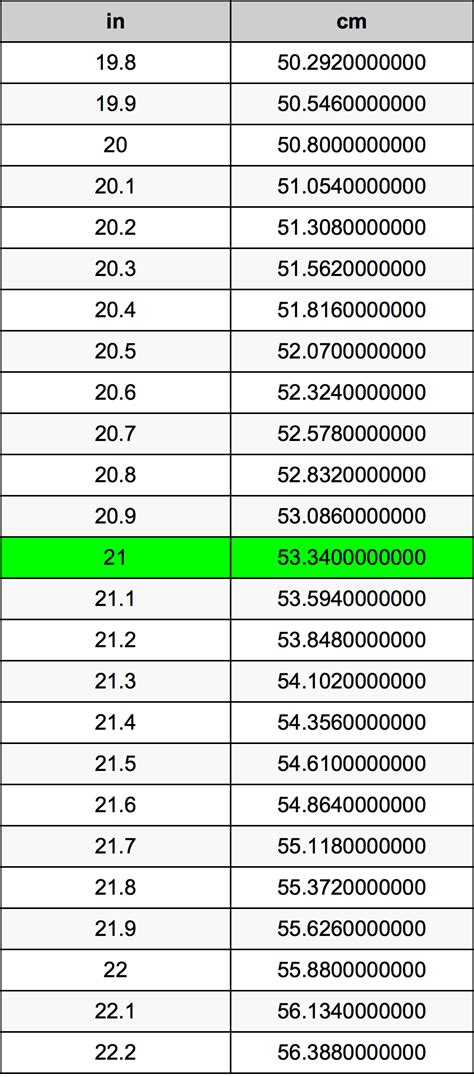How Big Is 21 Cm In Inches
Kalali
Apr 06, 2025 · 4 min read

Table of Contents
How Big Is 21 cm in Inches? A Comprehensive Guide to Metric-Imperial Conversions
Converting between metric and imperial units can sometimes feel like navigating a maze. Understanding the relationship between centimeters and inches is particularly crucial for various applications, from crafting and cooking to understanding medical measurements and international standards. This comprehensive guide will delve deep into the conversion of 21 centimeters to inches, explore the underlying principles, and provide you with the tools to perform similar conversions with confidence.
Understanding the Basics: Centimeters and Inches
Before we dive into the conversion of 21 cm to inches, let's quickly review the fundamental units.
-
Centimeter (cm): A centimeter is a unit of length in the metric system. It's a hundredth of a meter (1/100 meter). The metric system, based on powers of 10, makes conversions relatively straightforward.
-
Inch (in): An inch is a unit of length in the imperial system (used predominantly in the United States and a few other countries). The imperial system is less standardized, making conversions to other units sometimes more complex.
The key to converting between these units lies in understanding their precise relationship: 1 inch is approximately equal to 2.54 centimeters. This is a crucial conversion factor that we'll use repeatedly throughout this article.
Calculating 21 cm in Inches: The Conversion Process
Now, let's tackle the central question: how many inches are in 21 centimeters? We can use the conversion factor (1 inch ≈ 2.54 cm) to perform the calculation:
1. Set up the equation:
We want to convert 21 cm to inches. We can set up a simple proportion:
21 cm * (1 inch / 2.54 cm) = x inches
2. Perform the calculation:
The centimeters (cm) units cancel out, leaving us with inches (in):
21 / 2.54 ≈ 8.2677 inches
3. Rounding the result:
Depending on the level of precision required, you can round the result. For most practical purposes, rounding to two decimal places is sufficient. Therefore, 21 centimeters is approximately 8.27 inches.
Visualizing 21 cm (8.27 inches): Real-World Examples
To better grasp the size of 21 centimeters (or 8.27 inches), let's consider some real-world examples:
-
Length of a standard adult hand: The length of an average adult hand from the wrist to the tip of the middle finger is often around 20-22 cm, so 21 cm represents a hand-length measurement.
-
Width of a standard sheet of paper (A5): A5 paper, commonly used for printing and note-taking, has a width close to 21 cm.
-
Diameter of a dinner plate: Many standard dinner plates have a diameter of approximately 21-23 cm.
-
Length of a standard envelope: A standard-sized envelope might measure roughly 21-22 cm in length.
-
Height of a small plant: Many small potted plants reach heights between 20 and 22 cm.
These examples illustrate that 21 cm represents a moderately sized object, easily visualized in everyday scenarios.
Beyond the Basic Conversion: Exploring Further Applications
While converting 21 cm to inches is straightforward, understanding the underlying principles allows for broader applications. Let's explore some related scenarios:
Converting other centimeter measurements to inches
Using the same conversion factor (1 inch ≈ 2.54 cm), you can easily convert other centimeter measurements to inches. Simply multiply the centimeter value by the conversion factor:
- 10 cm: 10 cm * (1 inch / 2.54 cm) ≈ 3.94 inches
- 50 cm: 50 cm * (1 inch / 2.54 cm) ≈ 19.69 inches
- 100 cm (1 meter): 100 cm * (1 inch / 2.54 cm) ≈ 39.37 inches
Converting inches to centimeters
The conversion works in reverse as well. To convert inches to centimeters, you would multiply the inch value by 2.54:
- 5 inches: 5 inches * 2.54 cm/inch ≈ 12.7 cm
- 10 inches: 10 inches * 2.54 cm/inch ≈ 25.4 cm
- 12 inches (1 foot): 12 inches * 2.54 cm/inch ≈ 30.48 cm
Using online converters
Numerous online converters are readily available. These tools can handle conversions quickly and accurately. Simply input the centimeter value, and the converter will provide the equivalent in inches.
Addressing Potential Confusion: Precision and Rounding
While the conversion factor (1 inch ≈ 2.54 cm) is widely used, it's important to acknowledge that it's an approximation. The actual conversion factor is more precisely 2.54000508 cm per inch, resulting in slightly different answers depending on the number of decimal places used. For most everyday conversions, rounding to two decimal places provides sufficient accuracy. However, for highly precise scientific or engineering applications, more decimal places may be needed.
Conclusion: Mastering Metric-Imperial Conversions
Understanding how to convert between centimeters and inches is a valuable skill in today's interconnected world. The conversion of 21 cm to approximately 8.27 inches, as demonstrated in this guide, illustrates a fundamental process applicable to numerous scenarios. By mastering the conversion factor and understanding the principles outlined here, you can confidently navigate the metric and imperial systems, tackling conversions with ease and accuracy. Whether you're working on a DIY project, interpreting medical measurements, or simply satisfying your curiosity, this knowledge empowers you to effectively bridge the gap between these two systems of measurement. Remember to always consider the level of precision required when performing these conversions and choose your rounding appropriately.
Latest Posts
Latest Posts
-
What Is 64 Ounces Of Water
Apr 07, 2025
-
How Many Feet Is 216 Inches
Apr 07, 2025
-
How Many Cm Is 3 Meters
Apr 07, 2025
-
How Many Inches Is 8 Millimeters
Apr 07, 2025
-
Does The Type Of Liquid Affect How Fast Ice Melts
Apr 07, 2025
Related Post
Thank you for visiting our website which covers about How Big Is 21 Cm In Inches . We hope the information provided has been useful to you. Feel free to contact us if you have any questions or need further assistance. See you next time and don't miss to bookmark.